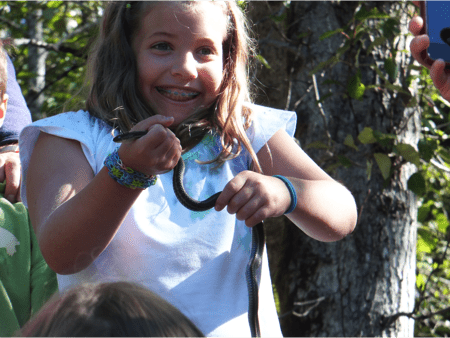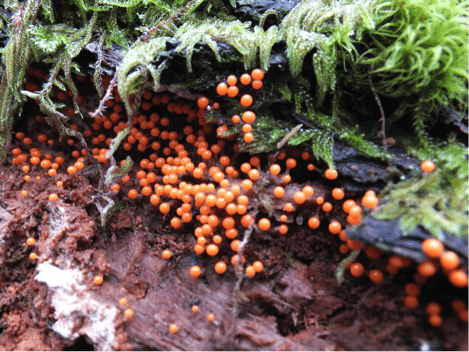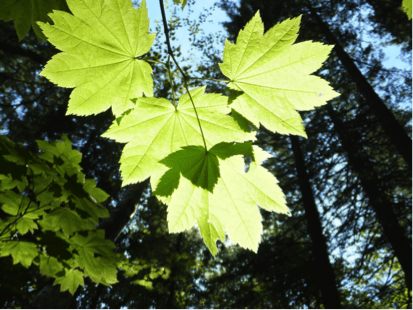Sensory Awareness: The Gateway to Environmental Empathy

Guest post by Katherine Storrs
Nothing beats the moments when you witness a student make connections between the environmental education lessons taught here at the North Cascades Institute and their local environment at home.
Whether the instructor at the Environmental Learning Center has been working in the environmental education field for 20 years or is interning for just a few months to complete an undergraduate degree requirement, like myself, we are all really here for one reason: the students. The silly and witty things that kids say bring so much laughter and amusement into our lives, and are often the rewards at the end of a long, challenging and occasionally difficult day in the field.
Case at hand: During my first solo teaching experience, I was talking about animal signs and how by paying attention to these signs, people can study animals without actually seeing them. I mentioned that one can tell a lot about an animal by their droppings or “scat”. When I asked the group what I meant by this, a ten-year-old girl’s hand shot up into the air and she proudly said, “I think it means an animal goes somewhere and poops, and then quickly gets out of there!” Scat! That little girl made me laugh until my belly ached.
Later that day, a boy in the same group made a connection I will never forget. After a lesson about freshwater distribution and resource management, the boy quietly raised his hand.
“What would the world be like with no water?” he asked.
Before I had a chance to respond, he answered his own question. “Because without water there would be no plants for the animals to eat and the animals would die.”
He barely paused to make the next, more philosophical jump. “I wouldn’t want to live in that world,” he said.
Moments like these – when the content from the lessons combines with the more emotional, empathetic potentials of an ecological education — make teachers feel as though they have the best job in the world. Fortunately for the world at large, we do not all have to be teachers to give children opportunities to connect to their environment.
 These tiny orange fungi are some of the easily-overlooked wonders of the woods. The practice of sensory awareness is greatly improved by getting down and dirty with rotting logs — a bugs-eye-view.
These tiny orange fungi are some of the easily-overlooked wonders of the woods. The practice of sensory awareness is greatly improved by getting down and dirty with rotting logs — a bugs-eye-view.
Teaching stretches far beyond the confines of the classroom or, in our case, the boundaries of North Cascades National Park. The majority of learning in a child’s life happens at home. It can be overwhelming to try and instill all of the moral values you want your child to gain to become a well-rounded, ethical adult, but not all values have to be hard to teach. For example, in terms of environmental ethics concerning other species, we have fuzzy animals on our side, and trust me, kids love fuzzy animals. Having worked with students aged two- to thirteen-years-old, I can say with confidence that the key to raising environmentally-conscious kids is sensory awareness.
Sensory awareness is a useful teaching technique, and is as accessible to all as the air we breath or the ground beneath our feet. It simply means that one engages all of their senses to develop a better picture of something. It can be done with a scheduled activity, such as doing a moss walk to find different species and discussing their texture, color, shape, smell, etc. It can also be more loosely framed, such as a “bio-blitz”, where you make a point to touch and investigate each plant you come across for a short period of time.
I was recently blessed by the opportunity to learn from a student with severe autism. What he needed to learn was to touch everything I pointed out, to get on the ground and look at a mushroom from the perspective of a mouse, to stand silently and listen to the leaves rustle in the wind, and to hear the beautiful trill of the American wren fill the air. With each whistle from a bird or gentle touch of the natural world, a smile would spread across his face and he’d let out a high-pitched laugh that was unavoidably contagious. This joy he felt resonated within me and left me thinking about the details we miss on a daily basis when we ignore opportunities to gain a more complete understanding of the world around us.
Towered over by the evergreen Douglas firs, mid-story vine maples are celebrated within the canopy for their flirtations with light and shadow.
Fortunately, you don’t need to be in a “pristine” mountain setting to get your five senses fired up. Rather, sensory awareness can be done anywhere, under any circumstance — on the way to and from school or work, even during tasks as mundane as waiting in line at the bank. Incorporating such an engaged state of being into the everyday is precisely what makes them so powerful in their ubiquity. All that’s required is that you feel, smell, taste, hear and see the world around you, all at the same time. When you do this with a child, you see their eyes light up. And if you can help a child develop a love for nature, you can bet they will grow up and want to take care of it.
All it takes is a little bit of time outdoors.
Katherine Storrs recently completed a seasonal internship with the North Cascades Institute where she taught Mountain School, developed a climate change lesson plan, and accomplished her triple goals of seeing a mountain goat, pika, and spawning salmon. She is now working to receive her B.S. in Environmental Science with a minor in Spanish. When she’s not teaching or being taught, she’s singing with her friends and preparing for volunteering with the Peace Corps.



the small orange balls is a slime mold, most probably hemitrichia sp. great work btw. Keep up and have fun.